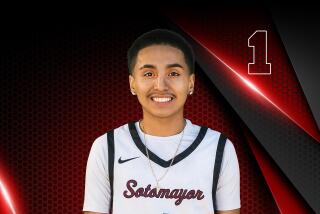Death of Young Murder Witness Provokes Outrage
POMONA — The death of 14-year-old Eduardo Samaniego, a clean-cut Little Leaguer who was shot to death just before he was to testify in a murder trial, has sparked community outrage and activism among members of Pomona’s Latino community.
Since the boy’s death Aug. 17, family friends and workers from two community organizations have organized prayer vigils, marches and meetings with city officials. They say authorities failed to protect the youth and did not inform his parents of the risks he faced testifying in a gang-related shooting.
They want changes in the way police and the county prosecutor’s office advise crime witnesses, particularly those whose first language is Spanish.
“We’re going to pursue this all the way to the top, to state officials,” said Lydia Guzman, one of the organizers.
Police Chief Lloyd Wood told about 200 demonstrators at a City Council meeting Monday that witness protection, a state-funded program for relocation and change of identity, is administered by the district attorney.
But Pomona acting Head Deputy Dist. Atty. Dick Jenkins said the job of explaining the program belongs to police. Likewise, police must initiate the request for protection, he said.
Michael Genelin, head of the district attorney’s hard-core gang unit, said the prosecutor’s office provides only the funding for the program and has given Pomona Police relocation money six times in two years.
“We don’t relocate the people, the police relocate the people,” Genelin said. But he added that families are often are reluctant to leave neighborhoods in which they have lived for years.
Faced with community pressure and mounting controversy, the City Council on Monday asked city staff to pursue county matching funds to offer a reward of from $10,000 to $15,000 in the case. Police have no suspects.
A quiet, churchgoing youth who lived in a tough, drug-dealing neighborhood in north Pomona, Samaniego witnessed a Nov. 10 drive-by shooting. Luis Lopez, 15, was shot to death in front of the Samaniego home, where about 15 other children were playing. Although many of the other witnesses feared coming forward, Samaniego testified in the February preliminary hearing against defendants Philip Salazar, 19, and Arthur Melendrez, 22.
The youth was prepared to testify at the trial. But the week it was to begin, someone came to the Samaniego home and asked for Eduardo, who left willingly. He was found an hour later, fatally wounded in a nearby alley.
Salazar and Melendrez face trial Sept. 30 in Pomona Superior Court.
Samaniego’s death galvanized activists from Soledad Enrichment Action, a youth program, and the East Valley Organization, a community group of parishioners from four Pomona churches.
“We want to work so that this won’t happen again to any of our children,” said Lourdes Vizcarra, one of the group members.
On Monday evening, more than 200 demonstrators gathered at Sacred Heart Roman Catholic Church, where Samaniego’s funeral was held last month, and marched to City Hall, chanting: “No to gangs! Yes to life!”
Several speakers told the council that the Samaniego family, whose native language is Spanish, did not understand that their son would be testifying in open court instead of anonymously behind a protective mirror. They said that the boy was informed of the court procedures by authorities but that his parents were not similarly counseled. They also said the family was mistakenly told that retaliation was not likely because the young witness was not a gang member.
Wood rebutted most of the accusations, saying that the family was properly advised and that the Police Department has bilingual officers and volunteer translators. But he said police will review their current procedures and make changes if necessary.
“The one thing that we have keyed in on is that in the case where we have juveniles involved as witnesses like this, we should spend more time with the parents than we did,” the chief said.
If witnesses appear uneasy or if threats are made, police advise them about the witness protection program, Wood said.
But he added, “Obviously, if we told every witness that there’s a good chance you could be killed, we would have no witnesses.”
Times correspondent Ned Boyer contributed to this article.
More to Read
Sign up for Essential California
The most important California stories and recommendations in your inbox every morning.
You may occasionally receive promotional content from the Los Angeles Times.










